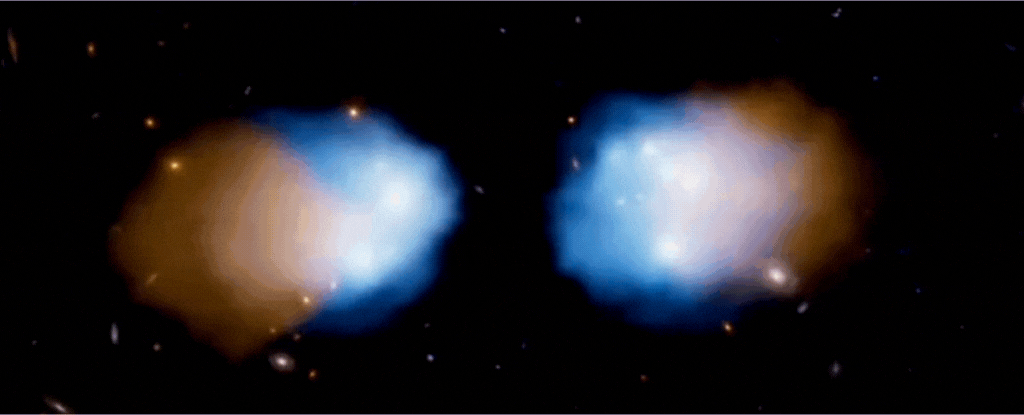Products You May Like
Two giant clusters of galaxies observed in the process of colliding are going so hard that their dark matter has basically detached from normal matter and flown ahead.
It’s like untethered cargo during a collision between two vehicles. Other forces stop the vehicles themselves, but the cargo, under the influence of momentum, keeps going.
It’s not the first time we’ve seen dark matter decouple from normal matter in the course of a giant cosmic collision, but we’ve never seen it in quite this fashion. And the finding, scientists hope, may give us new clues about the behavior and properties of the mysterious dark matter that dominates the Universe.
Dark matter is one of the great mysteries of the Universe. We don’t know what it is; nor can we detect it directly.
But there is, somehow, more gravity out there in the cosmos than we expect there to be, based on the “normal” matter that we can detect. A lot more gravity. We observe it in the motions of stars and galaxies, and in the way space-time itself bends and warps in the presence of powerful gravitational fields.
According to scientists’ calculations, only about 15 percent of the matter budget of the Universe is normal matter. The remaining 85 percent or so is this invisible, untouchable dark matter that only seems to interact with normal matter through gravity.
And it’s everywhere. Normal matter galaxies, such as our own, exist within giant blobs of dark matter. Vast strands of it make up what we call the cosmic web, gravitationally connecting galaxies to galaxies, clusters to clusters, providing routes normal matter can travel to meet, collide, and grow.
Normal matter has many other ways of interacting with other stuff, so massive events – such as collisions between clusters of galaxies – can get interesting. By and large, the galaxies within the clusters will be fine, but there are vast clouds of gas in the intracluster, intergalactic space that collide with each other, becoming hot and turbulent.
As that normal matter interacts electromagnetically, and as they experience shock and turbulence, a braking effect is applied, causing the clusters to slow down. But the dark matter is unaffected by these slowing influences, and keeps going, bounding ahead before eventually settling back into position around the newly merged cluster.
frameborder=”0″ allow=”accelerometer; autoplay; clipboard-write; encrypted-media; gyroscope; picture-in-picture; web-share” referrerpolicy=”strict-origin-when-cross-origin” allowfullscreen>
The merging clusters are collectively known as MACS J0018.5+1626, and they are oriented in such a way that allows for a new measurement of the velocities of matter within them.
A previous measurement was conducted on a cluster collision we are viewing side-on; MACS J0018.5+1626 is oriented so that one cluster appears to be heading directly towards us, and the other directly away.
The researchers used different techniques to measure the speeds of dark and normal matter.
The dark matter velocity was determined by measuring the speed of the galaxies within the clusters, based on how the light is stretched or compressed towards red or blue as it moves away from or towards us. This is known as the Doppler shift, and it’s a reliable way of measuring velocity in space.
The cluster member galaxies’ speed acts as a proxy for the dark matter’s speed, since galaxies and dark matter behave similarly during a cluster collision.
To measure the speed of the intracluster medium, the team relied on something called the Sunyaev-Zeldovich effect. This is a distinct warping seen in the background light of the Universe, caused by electrons in a volume of space. Since these electrons can scatter light, this effect can be used to determine how densely the electrons are packed.
A secondary effect can be observed if the scattering medium is moving, and scientists can analyze this effect to determine how the medium is moving: how fast, and in which direction.
This allowed the researchers to determine the velocity of the normal matter in the clusters, observing a distinct velocity difference between it and the dark matter as revealed by the galaxies.
It’s a very thorough work of astrophysical science that may aid us in our quest to understand exactly what the heck dark matter is.
“This study is a starting point to more detailed studies into the nature of dark matter,” Silich says. “We have a new type of direct probe that shows how dark matter behaves differently from normal matter.”
The research has been published in The Astrophysical Journal.
